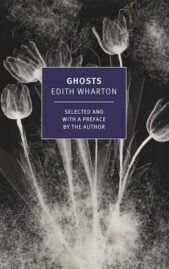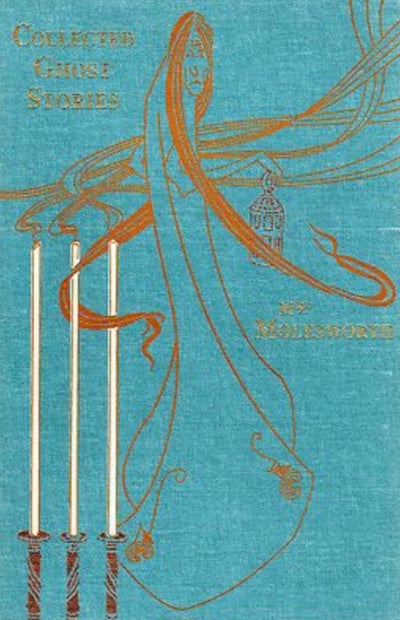All Souls’ & The Eyes: Two Uncanny Stories by Edith Wharton
By Francis Booth | On January 16, 2024 | Updated March 25, 2024 | Comments (0)

A surprising number of women authors, some of whom may be better known for writing more homelike novels, also wrote very “unhomelike” short stories. One was Edith Wharton, who understood that before leading us into the world of the tense and unsettling, the author first has to make us feel calm and settled.
Wharton said that this can be done by starting with a modern clean, electric-lit environment at least as well as with a gloomy old castle.
Sigmund Freud’s famous essay about weird literature is usually translated as The Uncanny. But the German word “unheimlich” literally means “unhomelike.”
No Direction Home by Francis Booth (©2023, from which this essay is excerpted, by permission) traces how uncanny literature takes us from the familiar, the reassuring, the homelike, into a world of the unfamiliar, the unsettling and the unhomelike.
Following is an introduction to Edith Wharton’s uncanny short stories, “All Souls’” and “The Eyes.”
. . . . . . . . .

No Direction Home by Francis Booth
is available on Amazon U.S*. and Amazon U.K.
. . . . . . . . .
All Souls’ by Edith Wharton (1937)
I read the other day in a book by a fashionable essayist that ghosts went out when electric light came in. What nonsense! The writer, though he is fond of dabbling in a literary way, in the supernatural, hasn’t even reached the threshold of his subject. As between turreted castles patrolled by headless victims with clanking chains, and the comfortable suburban house with a refrigerator and central heating where you feel, as soon as you’re in it, that there’s something wrong, give me the latter for sending a chill down the spine!
Edith Wharton story “All Souls’” starts, as does Edgar Allan Poe’s “The Black Cat” and many other uncanny tales do, by claiming to contain just simple facts related by a friend or relative of the person to whom the uncanny experience happens.
Queer and inexplicable as the business was, on the surface it appeared fairly simple — at the time, at least; but with the passing of years, and owing to there not having been a single witness of what happened except Sara Clayburn herself, the stories about it have become so exaggerated, and often so ridiculously inaccurate, that it seems necessary that someone connected with the affair, though not actually present — I repeat that when it happened my cousin was (or thought she was) quite alone in her house — should record the few facts actually known. . . So I have written down, as clearly as I could, the gist of the various talks I had with cousin Sara, when she could be got to talk — it wasn’t often — about what occurred during that mysterious weekend.
[“All Souls” is not yet in the public domain, so it’s difficult to find in full online. It’s part of several anthologies, and the lead story in Ghosts, a collection of her spooky stories collected by Wharton herself, not long before her death in 1937, the same year this story was written.]
“The Eyes” by Edith Wharton (1910)
In another, earlier Edith Wharton story, “The Eyes” is a tale presented as having been told by a member of a group of educated, rational friends sitting round a convivial but spooky fireplace in the dark, swapping ghost stories, which perhaps refers to the “dark and stormy night” when Mary Shelley’s Frankenstein and John Polidori’sThe Vampyre were both conceived. Read “The Eyes” in full.
We had been put in the mood for ghosts, that evening, after an excellent dinner at our old friend Culwin’s, by a tale of Fred Murchard’s — the narrative of a strange personal visitation. Seen through the haze of our cigars, and by the drowsy gleam of a coal fire, Culwin’s library, with its oak walls and dark old bindings, made a good setting for such evocations; and ghostly experiences at first hand being, after Murchard’s brilliant opening, the only kind acceptable to us, we proceeded to take stock of our group and tax each member for a contribution. There were eight of us, and seven contrived, in a manner more or less adequate, to fulfill the condition imposed. It surprised us all to find that we could muster such a show of supernatural impressions.
The first person perspective in uncanny stories
Uncanny stories – including virtually all of Poe’s – are often told in the first person, rather than by an omniscient narrator, because no individual can ever know the whole truth and can never offer a complete, rationalised version of events seen from all points of view.
A Jane Austen-style omniscient, judgemental narrator would have to come down off the fence. This authorial judging is why her Northanger Abbey is not uncanny (nor is it meant to be: it is meant as a spoof of the uncanny).
“Alas! If the heroine of one novel be not patronized by the heroine of another, from whom can she expect protection and regard? I cannot approve of it.”
Edith Wharton’s novels of manners, except for the rather uncanny Ethan Frome, with its frame narrative, are told in the third person with as stern a moral tone as Austen’s, whereas her uncanny short stories are mostly first-person. Uncanny stories are often told in the first person, because a single narrator cannot know everything as an omniscient narrator purports to.
. . . . . . . . .

See also: Classic Uncanny Stories by British Women Writers
. . . . . . . . .
Contributed by Francis Booth, the author of several books on twentieth-century culture: Amongst Those Left: The British Experimental Novel 1940-1960 (published by Dalkey Archive); Everybody I Can Think of Ever: Meetings That Made the Avant-Garde; Girls in Bloom: Coming of Age in the Mid-Twentieth Century Woman’s Novel; Text Acts: Twentieth-Century Literary Eroticism; Comrades in Art: Revolutionary Art in America 1926-1938; High Collars & Monocles: 1920s Novels by British Female Couples; and A Girl Named Vera Can Never Tell a Lie: The Fiction of Vera Caspary.
Francis has also published several novels: The Code 17 series, set in the Swinging London of the 1960s and featuring aristocratic spy Lady Laura Summers; Young adult fantasy series The Watchers; and Young Adult fantasy novel Mirror Mirror. Francis lives on the South Coast of England.
Leave a Reply